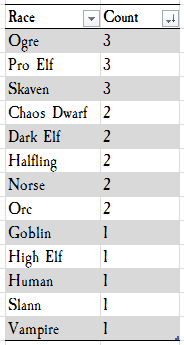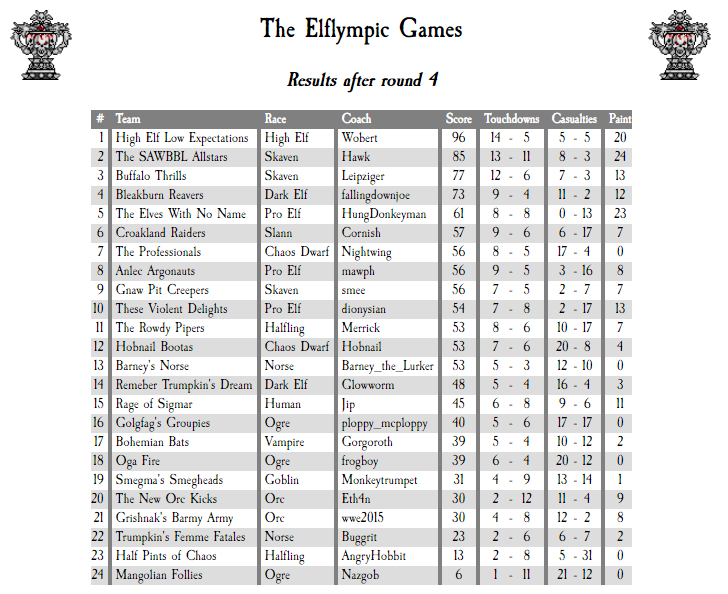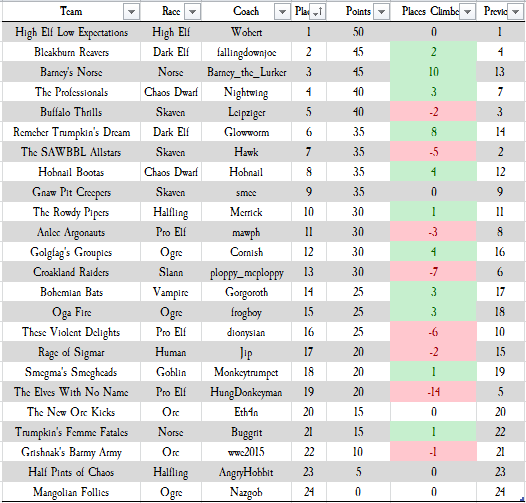Yesterday was the first Elflympic Games, a one-day four-game tournament run by myself. The rulespack can be found both on this blog and the dedicated website.
Here’s a quick summary though: 1,350k GP to build a team. Skills can be bought from the same budget, with no restrictions on doubles or spamming. Normal skills are 20k, doubles are 30k, with certain ‘luxury’ skills costing 40k and other ‘bargain bin’ skills costing 10k (regardless of being a double or not).
Win/Draw/Loss is worth 14/6/1 points, with 2 points per Touchdown, 1 per Completion, 2 per Long Bomb Completion, and 2 per Interception, with no caps on any of them.
This might cause some people – especially veteran tournament-goers – to double-take. Bonus points for completions and touchdowns, with no limits, with these Bonus Points being added to overall score? In fact, it generated so much controversy that it is has over 300 replies on the TFF thread since its creation in August, much higher than is typical of a British One-Dayer.
There were lots of concerns about a number of aspects of the Elflympics. Was it worthy of a NAF trophy? Does it undermine the sanctioning process? Does it invalidate the primacy of W/D/L? Was it competitive? Was it broken? Was it going to be fun? Was it fair?
I’m going to take a post-mortem look at the day, how it ran from my perspective, and analyse the results a bit too to see if we can answer some of these questions (from my own most-likely biased perspective!).
Firstly, I had twenty six coaches pay up, which was the limit of comfortable capacity for the venue. This suggests that either people wanted to come along to see whether the tournament was going to be as insane as people thought, or perhaps (and I hope this is the was the more common motivation!) people were intrigued by the alternative ruleset, and thought it could be fun.
(Just a quick aside – by ‘fun’ I mean the player enjoyed themself according to their own criteria. Different people come to Blood Bowl tournaments for different reasons, my idea of fun is likely different to yours. Some people enjoy the ultra-competitive side, some people enjoy the larks, most people are in the middle. When I say ‘fun’, I mean that the person walked away from the venue having gotten from the tournament whatever it is they wanted to get from it.)
It also helps that Yate (and by extension Bristol) is in prime Blood Bowl territory. It’s slap bang in the middle of the Welsh sides, Bristol sides, Swindon, Exeter, and to a further extent the Southampton/Midlands gaming groups. It has a train line that connects to Bristol/Gloucester, it’s fairly close to a junction from the M4. The Parish Hall itself is literally minutes walk from the train station and plenty of shops, chip shops, fast food, supermarkets etc. So I think that also helped get the numbers in.
One thing that became apparent is that many people rejected the idea of taking elves, despite the obvious bias in points. They went instead with anti-elf teams, with the expectation that they would face plenty of elves and so be perfectly prepared to take them down. What was interesting is that these people were originially in the majority!
I published a few rosters prior to the event, and there was concern from some people that with so many shutdown teams, chances are there would be matches between two shutdown teams that would boil down to a Metapod-off; two teams that are only good at stopping elves failing to impact each other significantly.
I published these rosters for a few reasons. The first was just for my own personal enjoyment! I had a great laugh writing some fluff for the event, and I couldn’t wait to get it out there. Secondly, it was meant as a gentle hint to the overall meta as it stood. Several people, inlcuding the overall winner (Wobert) alterted their rosters entirely when it became apparent the meta was going to Bash teams. Wobert saw there were actually relatively few elves, and changed to High Elves from Chaos Dwarves, and went on to win the tourney!
People also saw this fairly open style of team buildling coupled with the skill set as an opportunity to build unusual, specialist teams, more-or-less disregarding the meta. At least I think so, can’t think of any other reason why there were so many ogres!
Here’s the race breakdown:

Why so many Ogres!?
Seriously though, lets take a further look. Six of the twenty four teams were pure Elf teams, with entire teams of Agi4. However, these weren’t the only agility teams. There were also three skaven and one slann teams, with a Vampire team too (however as Gorgoroth was taking them purely for the 24, he only brought one vampire – Count Luthor!).
So with Skaven and Slann, there were ten Agility-focussed teams that could reasonably expect to score decent Bonus Points either through passing or scoring.
There were six stunty teams, so lots of competition for the stunty cup. The remaining teams were comprised of Norse, Chaos Dwarf, Orcs and a Human team. The teams not present were Wood Elf(!), Dwarf, Lizardmen, Amazon, Chaos, Chaos Pact, Khemri, Necromantic, Nurgle, Undead and Underworld.
The Present column represents the amount of teams that this race made up. The Normal column is the percentage of a tournament normally made up by this race (based on these numbers), and the difference is (obviously) the difference between the two.

Obviously this was a tiny sample, but it was nice to see lots of normally under-represented races making up a decent chunk of available teams.
Anyway, onto the important stuff: the scoring.
The focus was obviously on scoring quickly and scoring often, with additional points for showing off. To this end most of the Spot prizes were also designed in such a way as to encourage these even more. For example, one prize was for the next coach to score. This meant that if someone was planning on stalling for a few turns, they might instead be tempted to push harder and score now. Another was to make ten Go For It rolls in one turn (which Merrick managed to make!). This was again to make people throw what might be considered good tactics out the window, and instead ride their luck, in the hopes of a glorious payoff.
As a point of comparison I’m going to use the scoring system from the upcoming Welsh Open (which I recommend you check out – they’re a lovely bunch of guys, and damn talented at the game!). Their scoring system is as follows:
3 points for a win
1 points for a draw
0 points for a loss
No Bonus Points available.
To make it easier, I’m going to multiply the scores by a factor of 5. This doesn’t affect anything, it just makes a straight comparion simpler. Meaning it would look like this:
15 points for a win
5 points for a draw
0 points for a loss
No Bonus Points available.
As a reminder, the scoring for The Elflympic Games was:
14 points for a win
6 points for a draw
1 point for a loss
2 points for a Touchdown
2 points for an Interception
1 point for a Completion
2 points for a Long Bomb-range Completion
The biggest win in terms of Touchdowns at the Elflympics was a 5-0 win with 6 completions and an interception. In a normal scoring system, this would net 15 points, the same as a 1-0 or 2-1 grind. In Elflympics, it granted the player 32 points, worth over double the value of a single win. It would have taken some incredible dice to purely place this on luck, though this is most likely a factor. But it would have still needed a coach to push that luck, and to know when to hold back. Undoubtedly he could have stalled for a 2-0 win, with little to no completions. But because the rules rewarded the crazy plays, he kept going and secured a significant lead going into round two.
There were many other games with similar stories too. The final on the top table was an immense 4 – 4 on Touchdowns and 6 – 7 on completion points, netting the two players an incredible 20 and 21 points respectfully for the overall winner and the runner up.
Interestingly, they knew how many points each other had going into the final, so each knew exactly what they needed to win. If the 2nd place coach wanted to win, he needed to either outscore his opponent or draw, but really rack up the bonus points – or prevent his opponent from doing so. The coach in 1st place just needed the draw – provided he didn’t rest on his laurels and let his opponent farm points. (In the end, it came down to a Perfect Defense roll on turn 16 that prevented a very likely one-turn-touchdown for the touchdown, the win, and the tournament!)
The question is: was this good playing, and did it deserve extra points? If so, how much is too much?
Going into the final the two teams were 8 points apart. The game itself was the last game still being played, and was one of the most tense matches I’ve ever watched!
But lets look at the broader picture. An important aspect that many people are concerned with when it comes to Bonus Points in BB tournaments is what is called the ‘primacy of W/D/L’. What this means basically is that regardless of what happens, the person that wins the most games should win the day, and should not place higher than someone that did not win as many games. If you have the same amount of wins, then the person with the most amount of draws etc.
How did The Elflympics handle the primacy of W/D/L?

These are the results after round four. Now, lets substitute the scoring system for the 15/5/0

There are obviously a few differences! Interestingly Wobert still comes out on top. The biggest casualty is HungDonkeyman’s Pro Elves that dropped a mighty fourteen places. They had managed to place 5th with a fairly unimpressive W/D/L of 1/1/2 because of his 23 passing points and 16 Touchdown points. On the flip side, Barney’s Norse rocket from 13th to 3rd. While they had a relatively decent 3/0/1, with 53 points in total, they had only scored 5 Touchdowns with 0 Passing Points at all. This meant that despite a great performance they didn’t place as high as they should have, were this a normal tournament. Barney’s Norse only conceded three touchdowns all day, less than one a game, which suggests a well-fought grind in several games. While this is good tactics in normal Blood Bowl, in the Elflympics it meant that they did not place in the top half, landing slap-bang centre table.
It shows that a team with a poor W/D/L can place well, if they score well in bonus points. Conversely, a team with a good W/D/L can place low if they play a more conservative game.
Ultimately, this is sort of what I was hoping for. I wanted a crazy no-holds-barred day where people would be rewarded for pulling off the risky plays.
Was it broken? The fact that it came down to the last turn of the last game suggests to me that there was never a clear advantage to one team.
Was it fair? People went in knowing the rules from the outset.
Does it undermine the NAF sactioning process? Hmm, I think people who have been to more tournaments than me will have to answer that. There are teams that placed low in the tourney but did well in terms NAF ranking.
Was it competitive? Every award was contested up to the last game, from Casualties to Completions to Touchdowns. I think next year more people will bring elf and agility 4 teams, seeing how nine of the top ten races were agi 4 teams.
Was it fun? I hope so!
Will it be running again? You betcha 🙂
-T
p.s. if you want to play with the numbers yourself, here’s the Score file. I’m sure there are better analyses can be taken from the results.

Your going to need a bigger venue…….
LikeLike
Nice write up, thanks!
Oh and you spelled Gloucester wrong.
LikeLike
Shhhhh….
LikeLike